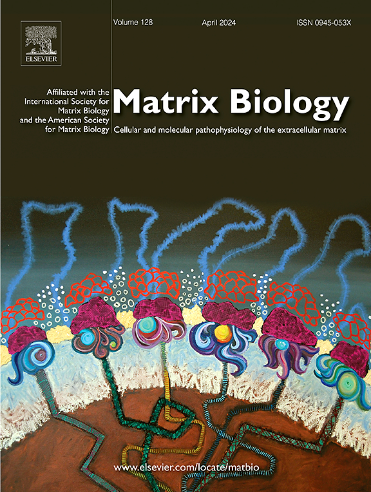基质结合纳米囊泡:在不到十年的研究中,对TERM有很大的希望
IF 4.8
1区 生物学
Q1 BIOCHEMISTRY & MOLECULAR BIOLOGY
引用次数: 0
摘要
脱细胞细胞外基质材料由于其固有的生物活性和免疫调节潜能,在组织工程和再生医学领域得到了广泛的研究。这些特性使脱细胞细胞外基质生物材料比其他生物材料,特别是合成生物材料具有生物学优势,导致在TERM中的一些成功应用。虽然脱细胞材料的复杂组成是众所周知的,并且被认为在提供再生优势中发挥作用,但其生物活性和免疫调节背后的精细机制尚未完全了解。在过去的十年中,研究人员在脱细胞细胞外基质材料中发现了一种新的成分:基质结合纳米囊泡(MBV)。这种新描述的细胞外囊泡类型的特点是与细胞外基质紧密相关,不同于其他液相囊泡,并且呈现出独特的组织特异性货物,被认为是由细胞分泌的特定细胞信号目的。尽管其他细胞外囊泡亚型在过去几年已经被广泛研究,但mbv在许多方面都是不同的,这使得这一研究领域明显年轻。主要的生物活性和免疫调节能力是mbv的关键特征,从最初的研究工作中就很明显。然而,为了理解mbv如何概括和赋予脱细胞生物材料其标志性的生物学性能,我们正在对它们进行深入的表征。特别是,它们丰富多样的货物正在被探索,这已被证明在mbv的生物学潜力中起着重要作用。这一发现不仅彻底改变了人们对脱细胞细胞外基质材料的看法,而且为研究一种新型生物材料开辟了道路,这种材料在治疗和再生应用方面具有很大的潜力。本文详细介绍了迄今为止关于mbv的研究进展、性质、生物学作用和长期应用潜力。本文章由计算机程序翻译,如有差异,请以英文原文为准。
Matrix bound nanovesicles: A great promise for TERM in less than a decade of research
Decellularized extracellular matrix materials have been widely studied for tissue engineering and regenerative medicine (TERM) applications, largely because of their intrinsic bioactivity and immunomodulatory potentials. These properties confer decellularized extracellular matrix biomaterials a biological advantage over other biomaterials, especially synthetic ones, leading to several successful applications in TERM. While the complex composition of decellularized materials is well known and thought to play a role in providing the regenerative advantage, the fine mechanisms laying behind their bioactivity and immunomodulation were not fully understood yet. In the last decade, researchers have discovered a novel component in decellularized extracellular matrix materials: the matrix bound nanovesicle (MBV). This newly described type of extracellular vesicle is characterized by a tight relation to the extracellular matrix, differently from other liquid phase vesicles, and presents a unique tissue specific cargo, thought to be secreted by cells for specific cell signalling purposes. Although other extracellular vesicles subtypes have been extensively studied in past years, MBVs are different in many ways, making this research field noticeably young. Major bioactivity and immune modulating ability are key features of MBVs that were evident right from the first research works. However, to understand how MBVs can recapitulate and confer decellularized biomaterials with their signature biological performance, they are being characterized in depth. In particular, their rich and varied cargo is being explored, which has shown to play a fundamental role in MBVs’ biological potential. This discovery not only revolutionized the look on decellularized extracellular matrix materials, but it also opened the way for research on a novel type of biomaterial, with plenty potential in therapeutical and regenerative applications. This review presents in detail what has been discovered up to now on MBVs, their properties, biological roles, and potential in TERM.
求助全文
通过发布文献求助,成功后即可免费获取论文全文。
去求助
来源期刊

Matrix Biology
生物-生化与分子生物学
CiteScore
11.40
自引率
4.30%
发文量
77
审稿时长
45 days
期刊介绍:
Matrix Biology (established in 1980 as Collagen and Related Research) is a cutting-edge journal that is devoted to publishing the latest results in matrix biology research. We welcome articles that reside at the nexus of understanding the cellular and molecular pathophysiology of the extracellular matrix. Matrix Biology focusses on solving elusive questions, opening new avenues of thought and discovery, and challenging longstanding biological paradigms.
 求助内容:
求助内容: 应助结果提醒方式:
应助结果提醒方式:


